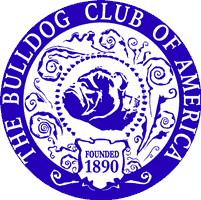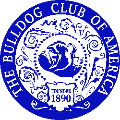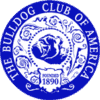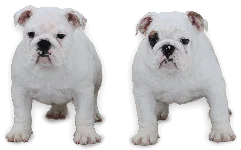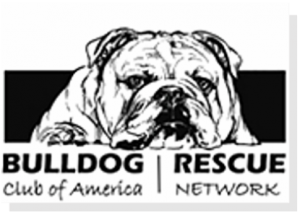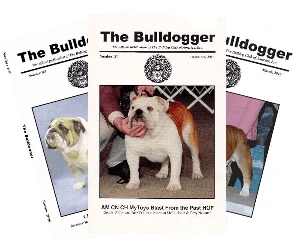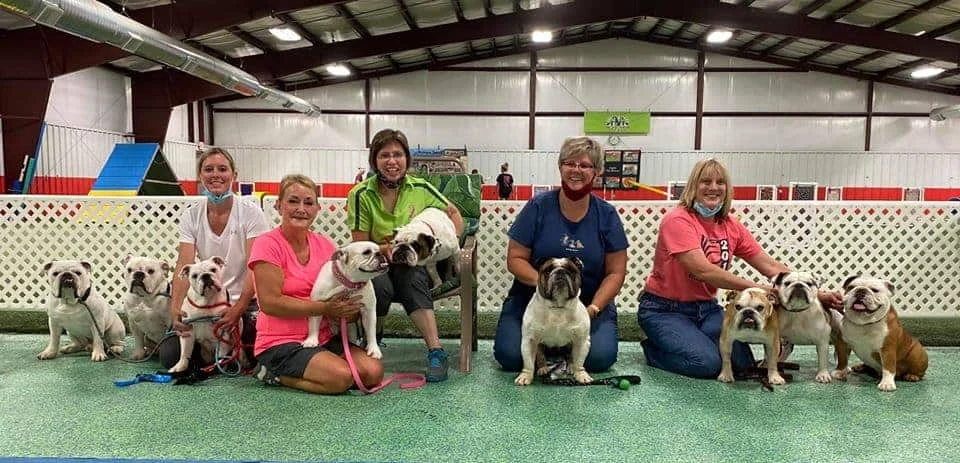Another bulldog-filled weekend of agility at TNT Dog Center in Midland Michigan. From the left Chelsie Bentz with *Ty, *Marshall and Mitchell, Pat Bentz with *Lulu, judge Ronda Bermke holding Gibson (run by Cindy Madill Berry), Cindy Madill with Booker, and April Paulman with *Boomer, Mindy and Billy.
*Four of the five Bulldogs that will (hopefully) be competing at the AKC Agility Invitationals are in the photo! Missing is Georgie who lives in another state.
Click to view the Top 5 Bulldogs Invitational Ranking List (AKC)
In order to acquire an agility title, a dog must earn a qualifying score in its respective class on three separate occasions under two different judges. Like Obedience, Agility titles are differentiated by the degree of difficulty associated with the exercises the dog has to perform. The AKC will identify dogs qualifying for titles by the appropriate title designations NA (Novice Agility), OA (Open Agility), AX (Agility Excellent), or MX (Master Agility Excellent)) following their registered names in all official AKC records. In each case, the higher title will supersede the preceding title in all official AKC records.
The maximum attainable score in any class is 100 points. The qualifying score (for placement) is 85 or above, with no disqualifying faults.
The higher the level the fewer faults allowed. Agility is fun for dogs of all sizes, from the small Yorkshire Terrier to the giant Irish Wolfhound.
In order to acquire the Master Agility Excellent title a dog must acquire the Agility Excellent title and earn qualifying scores in the Agility Excellent class at ten (10) licensed or member agility trials. Credit toward the Master Agility Excellent title cannot be earned at the trial where the dog acquires the Agility Excellent title.
The number of obstacles used for a class is specified for each class, with 12 to 13 obstacles used for Novice, 15 to 17 used for Open, and 18 to 20 used for Excellent. Certain obstacles are mandatory for each class. Unless otherwise noted, the additional obstacles used to provide the required number of obstacles must be either a Single Bar Jump or other Single Jump, Tire Jump or Open Tunnel. However, the One Bar Jump shall only be used in the Excellent Class.
Interested in Agility with a Bulldog?
Get ready for some challenging FUN!
Novice Agility Class: Requires a minimum of 12, maximum of 13 obstacles. There are 10 mandatory obstacles: A-Frame, Pause Table, Dog Walk, Open Tunnel, Seesaw, Closed Tunnel, Broad Jump, Panel Jump, Double Bar Jump, Tire Jump or Window Jump
Additional Obstacles: 2 to 3 (except One Bar and Triple Bar Jumps).
Open Class: Requires a minimum of 15and a maximum of 17 obstacles. There are 11 mandatory obstacles:
All of the 10 mandatory obstacles in Novice are required plus Weave Poles.
Additional Obstacles: 4 to 6 (may include one Triple Bar Jump but shall not include the One Bar Jump).
Agility Excellent Class: Requires a minimum of 18 and a maximum of 20 obstacles. There are 12 mandatory obstacles:
All of the Open Class obstacles and jumps are mandatory in the Excellent Class (the Broad Jump is optional) with the addition of the Triple Bar Jump, the One Bar Jump and additional jumps or tunnel to meet the minimum requirements.
Each Agility level requires the dog to navigate a set of obstacles, which vary by level. Not all obstacles are used at each level, but the requirements of the level specify form among which obstacles and how many are to be used at an event. The descriptions of the obstacles are as follows:
1. A-Frame: The A-Frame is constructed from two panels, the tops of which are constructed from wood or a wood-like substance. The panels are 35 to 49 inches wide, and their lengths are both within 2 inches of either 8 feet or 9 feet. The height of the A-Frame is within 1 inch of 4'11" when 8-foot panels are used and 5'6" when 9-foot panels are used. Dogs must ascend one panel and descend the other in the direction designated by the judge and they must touch the contact zone on the down side only, with any part of one foot.
2. Dog Walk: The Dog Walk consists of a center section and two ramp sections; each 12 feet long. Dogs must ascend one of the ramps, cross the center section, and descend the other ramp in the direction designated by the judge; and they must touch each contact zone with any part of one foot.
3. Seesaw (Teeter): The Seesaw consists of a plank (or panel) supported near the center by a base that acts as a fulcrum. The plank is 12 inches wide with a 1-inch tolerance, and 12 feet long. Dogs must ascend the plank, cause it to pivot in a controlled manner, and wait for the plank to touch the ground before dismounting. They must also touch each contact zone with any part of one foot.
4. Pause Table: The top of the Pause Table is a 36-inch square, plus or minus 2 inches, with a non-slip surface. Carpeting may be used. The height of the table (within 1 inch) is 8 inches for dogs in the 8-inch and 12-inch divisions, 16 inches for dogs in the 16-inch and 20-inch divisions, and 24 inches for dogs in the 24-inch division. Dogs must pause on the table for five seconds.
5. Open Tunnel: The Open Tunnel is a flexible tube of durable material that is capable of being formed into curved shapes. The two openings are either round or approximately rectangular, with a maximum height and width of 24 inches plus or minus 2 inches. Its length is 10 to 20 feet. (A 15-foot length is recommended.) It is set such that a dog cannot see the end of the tunnel from the entrance, and it is secured in position to prevent a dog from moving it. Dogs enter the end specified by the judge and exit the other end.
6. Closed Tunnel: The Closed Tunnel consists of a rigid entrance section to which a chute is attached. The opening of the entrance section is 24 to 36 inches long, and is either 24 inches in diameter or 24 inches in width and height, with a 2-inch tolerance.
-
- The major portion of the tunnel is formed by a clothe chute. It has only two openings, one of which is attached to the end of the entrance section, and one through which dogs exit the tunnel. The circumference of the chute flares from the circumference of the opening section to 96 inches at the exit. The length of the chute is such that the overall length of the Closed Tunnel is 12 to 15 feet.
- Dogs must enter the entrance section and exit through the chute.
7. Weave Poles: The Weave Poles consist of 6 (Novice) to 12 (Advanced and Excellent) poles that are either stuck in the ground or mounted in a base. Dogs must enter the Weave Poles by passing between #1 and #2 from right to left. They must then pass from left to right through poles #2 and #3 and continue this weaving sequence, following a smooth path, until they pass between the last two poles. If the sequence is broken, the dog must restart the correct sequence, either at or anywhere before the location of the error.
NOTE : for all Jump Exercises, there are six jump height divisions for dogs of different sizes: (a) 4 inches (for dogs <> inches and under at the withers, b) 8 inches (for dogs 10 inches and under at the withers); (c) l2 inches (for dogs 14 inches and under at the withers), (d) 16 inches (for dogs 18 inches and under at the withers); (3) 20 inches (for dogs 22 inches and under at the withers); and (f) 24 inches (for dogs over 22 inches at the withers). Also, there are "preferred classes" for all three (3) levels that allow the dog to jump at one height lower.
8. Single Bar Jumps: Single Bar Jumps consist of bars that are supported by bar supports that are mounted to uprights. Dogs must jump over the top bar, without displacing it, in the direction indicated by the judge.
9. Panel Jump: The Panel Jump uses up to six cross-boards to give the illusion of a solid wall. Dogs must jump over the top bar, without displacing it, in the direction indicated by the judge.
10. Other Single Jumps: Other single jumps are permitted. Their uprights and bar supports must conform to the specifications for the Single Bar Jump, as do the jump heights. Dogs must jump over the top cross-piece, without displacing it, in the direction indicated by the judge.
11. Double Bar Jump (Double Oxer): The Double Bar Jump consists of two parallel bars positioned at the jump heights specified for the Single Bar Jump. It may be built as a special jump or assembled from two Single Bar Jumps. The distance between the centers of the bars is one-half the jump height (within a 1/2-inch tolerance). Dogs must jump over the top bars, without displacing either one, in the direction indicated by the judge.
12. Triple Bar Jump: The Triple Bar Jump consists of a series of three ascending bars. All other specifications are the same as for the Single Bar Jump. Dogs must jump over all the bars without displacing any, in the direction that starts with the lowest bar.
13. Tire (Circle) Jump: The Tire Jump, sometimes called the Circle Jump, consists of a tire (or a circular object that resembles a tire) suspended from a rectangular frame. Dogs must jump through the tire opening in the direction specified by the judge.
14. Broad Jump: The Broad Jump is composed of either four 8-inch sections or five 6-inch sections, and four corner markers. The actual width of the 8-inch sections is 7 to 8 inches, and the width of the 6-inch sections is 5 to 7 inches. The sections are constructed from a top piece and two side pieces. The length of the sections are between 4 and 5 feet long, and they may be of different lengths. To improve visibility, either the center of the sections or both ends must be marked with a color-contrasting band that is at least 3 inches wide. The sections are of varying height, and they may be arranged in either ascending order or as a hogback. (The ascending AKC Obedience Broad Jump is recommended.)
-
- Dogs must jump all sections without touching any part of them, entering between the marker poles placed near the front section and exiting between the poles placed near the back section. When an ascending arrangement is used, the lowest section is the front, but when a hogback arrangement is used, the judge specifies the front.
